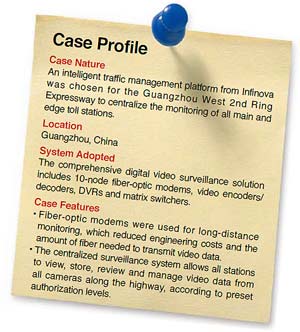Infinova provided a comprehensive digital video surveillance solution for fast, reliable, convenient and affordable surveillance for Guangzhou’s sprawling West 2nd Ring Expressway system.
Infinova provided a comprehensive digital video surveillance solution for fast, reliable, convenient and affordable surveillance for Guangzhou's sprawling West 2nd Ring Expressway system.
The Guangzhou West 2nd Ring Expressway, also known as the Xiaotang to Maoshan section of Guangzhou City Circular Highway, connects six expressways of approximately 42 kilometers. The highway surveillance system includes decentralized edge sites distributed along the expressways. Due to the long distances, transmission quality has been a challenge for this intelligent highway system.
Traditionally, point-to-point (PtP) digital fiber-optic modems have been used in such systems, but create problems despite competitive pricing. Also, as a PtP setup requires fiber to run from each edge site to the monitoring site, the amount of fiber needed for a highway surveillance system can be high. This increases the overall investment and the cost of installation.
For the expressways, a comprehensive digital video surveillance solution was needed, which integrates real-time video transmission, online storage, archive search and playback, and multiple levels of remote control. This ensures the system's improved security responses, faster handling of emergencies, timely and reliable video information for traffic management, and allows supervisors to call up and collect evidence.
 Solution
Solution
Two types of transmission modes were used to assure reliability within the surveillance system — a fiber-optic modem integrating with a traditional video matrix-switching system. One link can achieve real-time transmission of up to 10 channels of video with eight channels of bidirectional audio and data (or 16 channels bidirectional data), and two channels of reverse data and one channel of Ethernet.
Since the surveillance system must transmit many types of signals — video, audio and alarm — the most logical choice was to create a centralized transmission distribution mode. Video signals collected at each toll gate and from cameras along traffic lanes were sent to the closest communica- SUBMITTED BY INFINOVA tions station to be compressed and encoded by video encoders working with the on-site digital video storage server. Ultimately, the data is transmitted to the monitoring and management center via the fiber ring network. The resilient packet ring channel is dynamically distributed to fully leverage the fiber wiring, which guarantees real-time surveillance of emergencies and faster response to incidents, including counterterrorist activities.
The network video surveillance system software can assign priority for different management stations, such as the overall control center, expressway monitoring center and area subcenter. Authorization levels allow the center to remotely call up, control and store video from the edge sites. In addition, distributed management allows every toll station to call up videos from monitoring sites by using its individually managed matrix switcher. Video can be retrieved and transmitted manually, by schedule or events, and can be viewed live on Internet Explorer.
Result
The use of a node fiber-optic modem greatly reduced the engineering costs of the surveillance system. Deploying a standard time division multiplex and an add/drop multiplex approach, the node fiber-optic modems save the expressways fiber resources.
The industrial-grade OSE real-time main operating system assigns a unique internal 31-level priority of the network video encoder/decoder for multilevel priority management. Since it does not rely on server authorization control, the system is more stable.
The solution provides self and online checks for the encoder/decoder, DVR and their communication lines for troubleshooting purposes. With its rack encoder/ decoder, the system saves installation space at the local sites and the control center while ensuring easy maintenance for future system expansions.